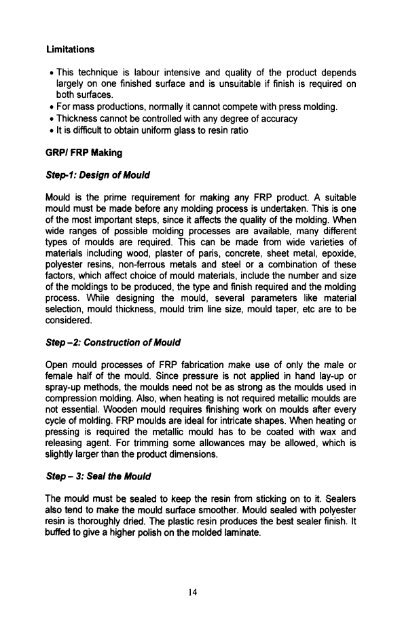Director Ambekar E. Eknath, Ph. D Head, APED J.K. Jena, Ph. D ...
Director Ambekar E. Eknath, Ph. D Head, APED J.K. Jena, Ph. D ...
Director Ambekar E. Eknath, Ph. D Head, APED J.K. Jena, Ph. D ...
Create successful ePaper yourself
Turn your PDF publications into a flip-book with our unique Google optimized e-Paper software.
Limitations<br />
. This technique is labour intensive and quality of the product depends<br />
largely on one finished surface and is unsuitable if finish is required on<br />
both surfaces.<br />
r For mass productions, normally it cannot compete with press molding.<br />
Thickness cannot be controlled with any degree of accuracy<br />
It is difficult to obtain uniform glass to resin ratio<br />
GRPl FRP Making<br />
Stepl: Design of Mould<br />
Mould is the prime requirement for making any FRP product. A suitable<br />
mould must be made before any molding process is undertaken. This is one<br />
of the most important steps, since it affects the quality of the molding. When<br />
wide ranges of possible molding processes are available, many different<br />
types of moulds are required. This can be made from wide varieties of<br />
materials including wood, plaster of paris, concrete, sheet metal, epoxide,<br />
polyester resins, non-ferrous metals and steel or a combination of these<br />
factors, which affect choice of mould materials, include the number and size<br />
of the moldings to be produced, the type and finish required and the molding<br />
process. While designing the mould, several parameters like material<br />
selection, mould thickness, mould trim line size, mould taper, etc are to be<br />
considered.<br />
Step -2: Construction of Mould<br />
Open mould processes of FRP fabrication make use of only the male or<br />
female half of the mould. Since pressure is not applied in hand lay-up or<br />
spray-up methods, the moulds need not be as strong as the moulds used in<br />
compression molding. Also, when heating is not required metallic moulds are<br />
not essential. Wooden mould requires finishing work on moulds after every<br />
cycle of molding. FRP moulds are ideal for intricate shapes. When heating or<br />
pressing is required the metallic mould has to be coated with wax and<br />
releasing agent. For trimming some allowances may be allowed, which is<br />
slightly larger than the product dimensions.<br />
Step - 3: Seal the Mould<br />
The mould must be sealed to keep the resin from sticking on to it. Sealers<br />
also tend to make the mould surface smoother. Mould sealed with polyester<br />
resin is thoroughly dried. The plastic resin produces the best sealer finish. It<br />
buffed to give a higher polish on the molded laminate.

















